Doubel Combustion Chamber
All Incinerators are Doubel Combustion Chamber with One Fuel Burner Each. After Burner Technology for Completely Combustion and Cleaner World.
Read MoreHigh Temperature Incineration
Temperature Range 800 Degree to 1200 Degree in Combustion Chamber. Temperature Thermocouple Monitor and Controller. High Quality Fire Brick and Refactory Cement.
Read MoreGet Lastest News
There are latest incinerator news like technical, public news, business tender for medical waste incinerator,animal incineration, pet cremation
Read MoreNanjing Clover Medical Technology Co.,Ltd.
Email: sales@clover-incinerator.com | Tel: +86-25-8461 0201
Regular model incinerator for market with burning rate from 10kgs to 500kgs per hour and we always proposal customer send us their require details, like waste material, local site fuel and power supply, incinerator operation time, etc, so we can proposal right model or custom made with different structure or dimensions.
Incinerator Model YD-100 is a middle scale incineration machine for many different usage: for a middle hospital sickbed below 500 units, for all small or big size family pets (like Alaskan Malamute Dog), for community Municipal Solid Waste Incineration, etc. The primary combustion chamber volume is 1200Liters (1.2m3) and use diesel oil or natural gas fuel burner original from Italy.
Latest Post
Medical Waste Incineration in Pakistan
Medical Waste Incineration in Pakistan: Market Demand, Current Use, and Technical Trends
Current Market Situation
Pakistan, with over 240 million people and a large network of public and private hospitals, laboratories, and clinics, faces a growing challenge in safely managing infectious medical waste.
According to the Pakistan Environmental Protection Agency (Pak-EPA) and the Hospital Waste Management Rules (2005), hospitals are legally required to segregate, treat, and dispose of hazardous waste properly. Despite this, field reports and NGO assessments highlight that:
-
Many hospitals lack compliant incinerators, especially in rural and district-level facilities.
-
Where incinerators do exist, many are outdated single-chamber units or brick-built models with limited temperature control.
Recent Public Tenders and Projects
In recent years, multiple provincial health departments and donor-funded projects have issued tenders and public procurement notices to modernize healthcare waste management:
-
Punjab Health Department (2022C2023): invited bids for dual-chamber, natural gas-fired incinerators of 100 kg/hour and 200 kg/hour capacity for major teaching hospitals, including those in Lahore and Multan.
-
Sindh Government (Karachi): funded new incineration facilities at major hospitals and a central waste treatment site designed to serve multiple smaller hospitals.
-
Khyber Pakhtunkhwa (Peshawar region): planned installation of small natural gas incinerators in district hospitals to handle sharps, laboratory waste, and pathological waste.
-
Islamabad Capital Territory (ICT): recent news reports confirm the installation of new dual-chamber gas-fired incinerators in government hospitals like Pakistan Institute of Medical Sciences (PIMS).
These projects reflect both donor funding (e.g., Asian Development Bank health programs) and direct provincial government budgets.
Technical Preferences and Requirements
A clear trend has emerged in Pakistan’s market towards:
-
Natural gas-fired incinerators: driven by the widespread availability of piped gas in major cities and cost-effectiveness compared to diesel.
-
Dual-chamber designs: with a secondary combustion chamber maintaining ≥850°C to comply with WHO guidelines.
-
Capacity range: demand covers both:
-
Small units (20C50 kg/hour) for district hospitals and laboratory clusters.
-
Medium units (100C200 kg/hour) for teaching and tertiary hospitals.
-
Additional technical requirements frequently specified in tender documents:
-
Automated burners (Italy or equivalent).
-
PLC-based control panels for temperature regulation and real-time monitoring.
-
Chimneys of ≥10C12 meters for safe emissions dispersion.
-
Optional wet scrubber or filter systems to limit particulate and acidic gas emissions.
Market Drivers
-
Regulatory pressure: enforcement of the Hospital Waste Management Rules and updated Punjab Environmental Quality Standards (PEQS) for emissions.
-
Public health awareness: amplified after COVID-19, with increased volume of PPE and infectious waste.
-
Donor-funded programs: particularly those tied to maternal health, vaccination, and emergency preparedness.
-
Urbanization: large hospitals in Karachi, Lahore, and Islamabad handling growing patient numbers, thus generating more hazardous waste.
Examples of Facilities Using or Procuring Modern Incinerators
-
PIMS Islamabad: installed a modern gas-fired dual-chamber incinerator to handle waste from multiple wings.
-
Jinnah Hospital Karachi and Civil Hospital Karachi: included in Sindh Government’s program to modernize waste treatment.
-
Mayo Hospital Lahore: part of Punjab Health Department’s plan to replace older incinerators with high-efficiency gas-fired models.
-
In rural areas, some small private hospitals have purchased containerized gas incinerators, including imported models from China and Europe.
Environmental and Operational Considerations
Pakistan’s preference for natural gas incinerators offers:
-
Lower operational costs where piped gas is available.
-
More stable combustion and fewer particulates compared to diesel units.
-
Compliance with WHO recommendations for controlled combustion.
However, challenges remain:
-
Many smaller clinics still dump waste at municipal sites or rely on small-scale burning.
-
Need for operator training and maintenance services to keep modern incinerators running efficiently.
Pakistan’s healthcare system shows a clear and growing demand for natural gas-fired, dual-chamber medical waste incinerators, driven by regulatory standards, urban hospital expansion, and international support.
For suppliers and manufacturers―like HICLOVER―this presents opportunities to offer:
-
Containerized and fixed gas-fired incinerators.
-
PLC-controlled systems with compliance to PEQS and WHO standards.
-
Service support and training, particularly for provincial health departments rolling out district-level waste treatment.
For detailed technical proposals or case studies relevant to Pakistan’s health sector, visit:
www.hiclover.com
or contact: sales@hiclover.com
Advanced Waste Solutions for Libya’s Oil Fields
Advanced Waste Solutions for Libya’s Oil Fields: HICLOVER Containerized Incinerators in Action
As Libya rebuilds its oil and gas industry amid post-conflict recovery and increasing foreign investment, the need for environmentally responsible waste management in remote oil bases and field operations is more urgent than ever. In such environments, HICLOVER’s containerized incinerator systems—notably the TS300 and TS500 models—are proving to be essential infrastructure for waste control and environmental compliance.
The Context: Waste Challenges in Libya’s Oil Fields
Libya’s oil industry operates across vast, arid regions such as:
-
The Sirte Basin
-
Murzuq and Ghadames Basins
-
Waha, El Sharara, and Zawiya oil fields
These operations often involve:
-
Hundreds of personnel at remote exploration and production sites
-
Continuous waste generation from canteens, accommodation camps, workshops, and medical stations
Common waste includes:
-
Domestic solid waste (food, plastics, packaging)
-
Hazardous waste (contaminated PPE, oily rags, expired chemicals)
-
Medical waste (from on-site clinics)
Without proper disposal, such waste poses serious risks to worker health, groundwater, and desert ecosystems.
HICLOVER’s Solution: Mobile Containerized Incinerators
To address these challenges, HICLOVER has supplied its TS300 and TS500 series containerized incinerators—designed specifically for high-capacity field waste management in oil and gas environments.
Key Models in Use
 TS300 Containerized Incinerator
TS300 Containerized Incinerator
-
Burn Rate: 300 kg/hour
-
Feed Capacity: 500–700 kg/feeding
-
Design: Fully enclosed in 20/40-foot ISO container
-
Control System: PLC automatic with remote diagnostics
-
Chambers: Dual combustion chambers for complete burning
-
Emission Control: Optional wet scrubber or dry filtration
-
Fuel Type: Diesel or LPG
-
Mobility: Crane-liftable, ideal for shifting between drilling blocks
 TS500 Containerized Incinerator
TS500 Containerized Incinerator
-
Burn Rate: 500 kg/hour
-
Feed Capacity: 800–1000 kg/feeding
-
Advanced Features:
-
Triple-chamber combustion
-
Heat-retention insulation rated to 1750°C
-
Integrated ash removal system
-
Optional continuous feeding mechanism
-
Smart sensors for temperature, oxygen, and pressure monitoring
-
These models are ideal for large oil camps operating 24/7, where massive waste volumes must be treated on-site and in compliance with environmental regulations.
how the waste incinerators work and their constituent parts
Medical Waste Incineration and Medical Incinerators
1. Burning Capacity
i. Incinerator should be capable to burn waste @ 100 kg / hr in single loading.
2. Construction
i. Packaged type skid mounted dual chamber construction
ii. Stainless steel or Mild steel outer with thickness 5mm or more, sheet should be painted with heat resistant and anti-corrosive paint.
iii. Internal surface of incinerator should be line with non– cracking refractory bricks made of ceramics or concrete to withstand the temperature of 1400 oC, furthermore bricks must be backed by thermal insulation and have thickness in between
220C250 mm.
iv. There should be thermal insulation of high performance calcium silicate (Density 230Kg.m-3)to withstand high temperature with flame spread/smoke index not more than 1.
v. Refractory and thermal insulation must be designed in robust way so that outer temperature on sheet does not rise above 55–
60 oC even after continuous operation of 12 hours.
3. Primary Chamber
i. Chamber be designed with capacity to load 100kg medical waste with volume at least 1.2m3 or more, chamber must have separate door for loading of waste and for removal of ash using manual ash removing tool.
ii. Pyrolytic burning mechanism with burning temperature not below than 900 oC.
iii. Blower Centrifugal fan (according to manufacturer design) will be provided to inject air for burning waste and gases in primary combustion chamber furthermore air regulation and distribution will be automatic and electronically controlled.
iv. Chamber should have electrically operated natural gas burner.

Tel: +86-25-8461 0201
Website: www.hiclover.com
Email: sales@hiclover.com
Email: hicloversales@gmail.com
| Items/Model | TS10(PLC) | TS20(PLC) | TS30(PLC) | TS50(PLC) | |
| Burn Rate (Average) | 10 kg/hour | 20 kg/hour | 30 kg/hour | 50 kg/hour | |
| Control Mode | PLC Auto. | PLC Auto. | PLC Auto. | PLC Auto. | |
| Combustion Chamber | 100L | 210L | 330L | 560L | |
| Internal Dimensions | 50x50x40cm | 65x65x50cm | 75x75x60cm | 100x80x70cm | |
| Secondary Chamber | 50L | 110L | 180L | 280L | |
| Smoke Filter Chamber | Dry Scrubber | Dry Scrubber | Dry Scrubber | Dry Scrubber | |
| Feed Mode | Manual | Manual | Manual | Manual | |
| Voltage | 220V | 220V | 220V | 220V | |
| Power | 0.75Kw | 0.83Kw | 0.99Kw | 1.2Kw | |
| Diesel Oil Consumption (kg/hour) | Ave.8.4 | Ave.10.9 | Ave.13.3 | Ave.16.9 | |
| Natural Gas Consumption (m3n/hour) | Ave.10.1 | Ave.13 | Ave.16 | Ave.20.2 | |
| Temperature Monitor | Yes | Yes | Yes | Yes | |
| Temperature Protection | Yes | Yes | Yes | Yes | |
| Items/Model | TS100(PLC) | TS150(PLC) | TS300(PLC) | TS500(PLC) | |
| Burn Rate (Average) | 100 kg/hour | 150 kg/hour | 300 kg/hour | 500 kg/hour | |
| Control Mode | PLC Auto. | PLC Auto. | PLC Auto. | PLC Auto. | |
| Combustion Chamber | 1200L | 1500L | 2000L | 3000L | |
| Internal Dimensions | 120x100x100cm | 150x100x100cm | 170x120x100cm | 210x120x120cm | |
| Secondary Chamber | 600L | 750L | 1000L | 1500L | |
| Smoke Filter Chamber | Dry Scrubber | Dry Scrubber | Dry Scrubber | Dry Scrubber | |
| Feed Mode | Manual | Manual | Manual | Manual | |
| Voltage | 220V | 220V | 220V | 220V | |
| Power | 1.38Kw | 1.69Kw | 2.57Kw | 4.88Kw | |
| Diesel Oil Consumption (kg/hour) | Ave.20.4 | Ave.24.2 | Ave.33 | Ave.44 | |
| Natural Gas Consumption (m3n/hour) | Ave.24.5 | Ave.29 | Ave.39.6 | Ave.52.8 | |
| Temperature Monitor | Yes | Yes | Yes | Yes | |
| Temperature Protection | Yes | Yes | Yes | Yes | |
HOSPITAL WASTE INCINERATOR 50-60KG / HR
|
Incinerator Items/Model |
HICLOVER TS30(PLC)
|
HICLOVER TS50(PLC)
|
HICLOVER TS100(PLC)
|
|
|
Burn Rate (Average) |
30-50 kg/hour |
50-100 kg/hour |
100-150 kg/hour |
|
|
Feed Capacity(Average) |
60kg/feeding |
100kg/feeding |
350kg/feeding |
|
|
Control Mode |
PLC Automatic |
PLC Automatic |
PLC Automatic |
|
|
Primary Combustion Chamber |
330L(0.33M3) |
560L(0.56M3) |
1810L(1.81M3) |
|
|
Internal Dimensions |
75x75x60cm |
100x80x70cm |
165x110x100cm |
|
|
Secondary Chamber |
180L |
280L |
660L |
|
|
Smoke Filter Chamber |
Yes |
Yes |
Yes |
|
|
Feed Mode |
Manual |
Manual |
Manual |
|
|
Voltage |
380V±10%, 50Hz |
380V±10%, 50Hz |
380V±10%, 50Hz |
|
|
Power |
5.0Kw |
6.0Kw |
8.0Kw |
|
|
Burner Type |
Italy Brand |
Italy Brand |
Italy Brand |
|
|
Oil Consumption (kg/hour) |
12 |
12 |
16 |
|
|
N.Gas Consumption (m3n/hour) |
16 |
21 |
25 |
|
|
Temperature Monitor |
Yes |
Yes |
Yes |
|
|
Temperature Thermometer |
Corundum Probe Tube, 1400℃Rate. |
Corundum Probe Tube, 1400℃Rate. |
Corundum Probe Tube, 1400℃Rate. |
|
|
Temperature Protection |
Yes |
Yes |
Yes |
|
|
Automatic Cooling |
Yes |
Yes |
Yes |
|
|
Automatic False Alarm |
Yes |
Yes |
Yes |
|
|
Automatic Protection Operator(APO) |
Yes |
Yes |
Yes |
|
|
System Testing Model |
Yes |
Yes |
Yes |
|
|
Time Setting |
Yes |
Yes |
Yes |
|
|
Progress Display Bar |
LCD Display |
LCD Display |
LCD Display |
|
|
Oil Tank |
200L |
200L |
200L |
|
|
Oil Tank Stand |
190cm Height |
190cm Height |
190cm Height |
|
|
Liquid level Display |
Yes |
Yes |
Yes |
|
|
Feeding Door |
40x40cm |
50x50cm |
60x70cm |
|
|
Chimney |
10Meter |
10Meter |
10Meter |
|
|
Chimney Type |
Stainless Steel 304 |
Stainless Steel 304 |
Stainless Steel 304 |
|
|
1st. Chamber Temperature |
800℃–1000℃ |
800℃–1000℃ |
800℃–1000℃ |
|
|
2nd. Chamber Temperature |
1000℃-1300℃ |
1000℃-1300℃ |
1000℃-1300℃ |
|
|
Residency Time |
2.0 Sec. |
2.0 Sec. |
2.0 Sec. |
|
|
Gross Weight |
4000kg |
6000kg |
8000kg |
|
|
External Dimensions |
200x140x160cm |
250x150x180cm |
280 x 180 x 200cm |
|
|
1st. Chamber Composition Hot Face |
Thickness: ≥180 mm |
Thickness: ≥180 mm |
Thickness: ≥180 mm |
|
|
55% of Al203 |
55% of Al203 |
55% of Al203 |
||
|
1750°C Grade |
1750°C Grade |
1750°C Grade |
||
|
2nd. Chamber Composition Hot Face |
Thickness: ≥180 mm |
Thickness: ≥180 mm |
Thickness: ≥180 mm |
|
|
75% of Al203 |
75% of Al203 |
75% of Al203 |
||
|
1790°C Grade |
1790°C Grade |
1790°C Grade |
||
|
Chamber Cold Face Material |
High Rate Refractory Ceramic Fiber |
High Rate Refractory Ceramic Fiber |
High Rate Refractory Ceramic Fiber |
|
|
Other Parts Hot Face Refractory |
Heavy Duty with steel fiber |
Heavy Duty with steel fiber |
Heavy Duty with steel fiber |
|
|
Burner operation |
Automatic On/Off |
Automatic On/Off |
Automatic On/Off |
|
|
Dry Scrubber |
Including |
Including |
Including |
|
|
Wet Scrubber |
Optional |
Optional |
Optional |
|
|
Top Loading Door |
Optional |
Optional |
Optional |
|
|
Paint for outside face |
250°C Grade |
250°C Grade |
250°C Grade |
|
|
Sealing Material |
Refractory Ceramic Fiber |
Refractory Ceramic Fiber |
Refractory Ceramic Fiber |
|
|
Upgrade Containerized Mobile Type |
Optional |
Optional |
Optional |
|
|
CE Certificate |
CE(2006/42/EC,2014/30/EU |
CE(2006/42/EC,2014/30/EU |
CE(2006/42/EC,2014/30/EU |
|
|
ISO Certificate |
ISO9001:2015 |
ISO9001:2015 |
ISO9001:2015 |
|
|
High-tech Enterprise Certificate |
Yes |
Yes |
Yes |
|





















